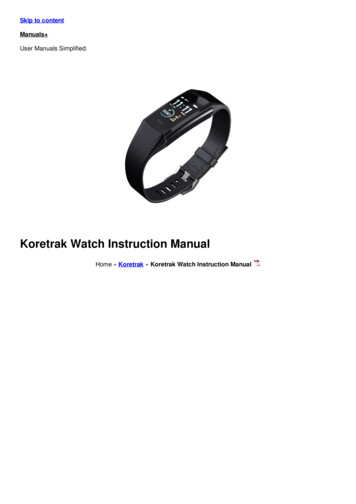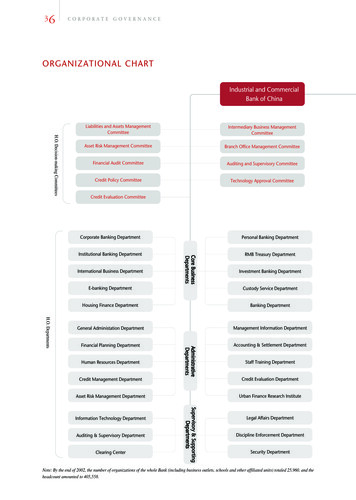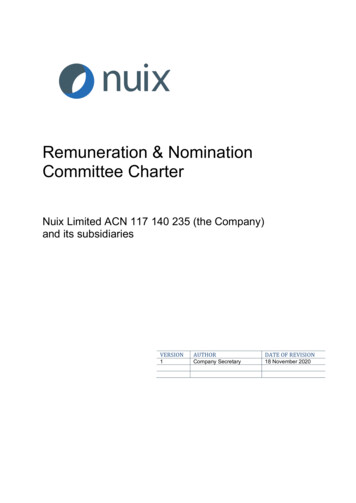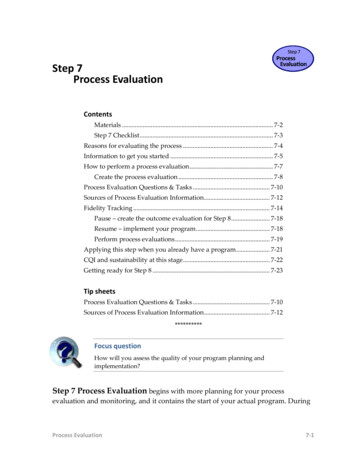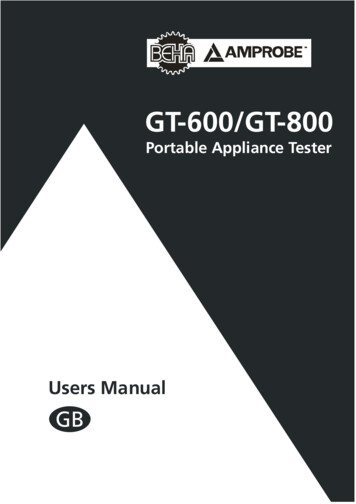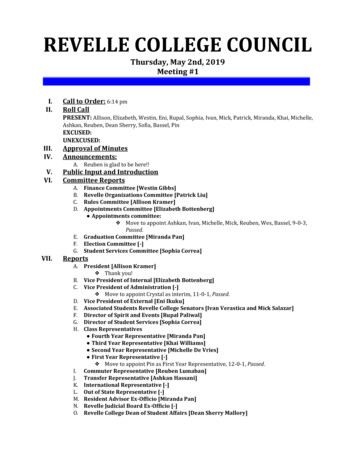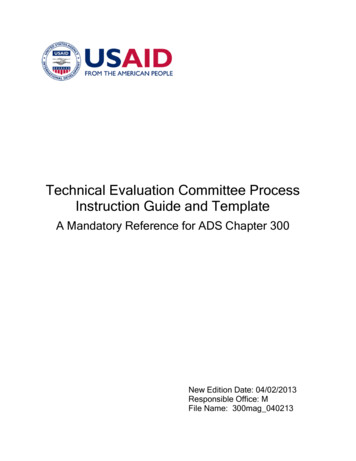
Transcription
Technical Evaluation Committee ProcessInstruction Guide and TemplateA Mandatory Reference for ADS Chapter 300New Edition Date: 04/02/2013Responsible Office: MFile Name: 300mag 040213
TECHNICAL EVALUATION COMMITTEEMEMBER GUIDE AND TEMPLATEBUREAU FOR MANAGEMENT (M)OFFICE OF ACQUISITIONS AND ASSISTANCETEMPLATES SERIESMAY 2012
IntroductionThe purpose of the guidance is to convey to you responsibilities of individuals serving asmembers of a technical evaluation committee. The technical evaluation process is an analysisof each offeror’s proposal with respect to the standards and criteria established in the sourceselection plan and as set forth in the solicitation. The Technical Evaluation Committee’s(TEC) objective is to evaluate each offeror’s technical proposal against the evaluation factorsestablished in the solicitation to determine if the offeror is able to the perform the tasks thatare outlined in the Statement of Work (SOW). It is imperative that each member of the TECbecome familiar with the solicitation and all supporting documents referenced in thesolicitation before looking at the offeror’s technical proposal. Each evaluator independentlyscores/rates each technical proposal and documents in narrative the offeror’s strengths,weaknesses, significant weaknesses and deficiencies as it relates to the evaluation factors andsub-factors outlined in the solicitation.In order to obtain a comprehensive understanding of the evaluation process you should alsoreview the following guidance: Source Selection Plan Guidance and Template, TechnicalEvaluation Committee Chairperson Guide and Template, Technical Evaluation CommitteeProcess Instruction Guide and Template, Cost Realism Key Components Guidance andChecklist and the Harmonization Guidance Section C (SOW) – to - Section L and M.Audience Agreement Officer Agreement Officer’s Technical Representative Contracting Officer Contracting Officer’s Technical Representative Contract Specialist Program Analyst/Activity Manager Agreement Specialist Budget Officer Technical Evaluation CommitteeAcronymsCOCORCRBCRCTOFARGCContracting OfficerContracting Officer RepresentativeContract Review BoardCompetitive RangeCognizant Technical OfficeFederal Acquisition RegulationOffice of the General Counsel
IQCOAAOSDBURFPSSASSPTECIndefinite Quantity ContractOffice of Acquisition and AssistanceOffice of Small and Disadvantaged Business UtilizationRequest for ProposalSource Selection AuthoritySource Selection PlanTechnical Evaluation CommitteeKey Roles and ResponsibilitiesSource Selection Authority (SSA) is the individual designated to make the best-valuedecision. The SSA is the CO unless another individual has been designated in writing by theappropriate authority. The CO decision shall be based on a comparative assessment ofproposals against all source selection criteria in the solicitation. While the CO may usereports and analyses prepared by others, the source selection decision shall represent theCO's independent judgment.Contracting Officer (CO) is responsible for coordinating with the Activity Manager todefine the acquisition requirements, entering into, administering, and terminating USAIDdirect contracts in accordance with the limitations of their delegated authority, policydirectives, and required procedures.Technical Evaluation Committee (TEC) Chairperson is responsible for the overallmanagement of the TEC, can also be an elevator, and act as the TEC’s interface to the CO.The TEC chairperson is responsible for ensuring the adequacy of documentation and theteam’s evaluation of the proposals received.Contracting Officer’s Representative (COR) is designated by the Contracting Officer, andis responsible for the technical oversight and administration of the activity during contractperformance.Contract Review Board (CRB) is often comprised of Contracting Officers, members fromEvaluation and Policy offices and when required, a representative of General Counsel. TheCRB is responsible for reviewing documentation for acquisition actions (pre-solicitation,competitive range determination, and pre-award) that are expected to exceed 25M. Thisincludes basic Indefinite Quantity Contracts (IQCs) with the total estimated ceiling expectedto exceed 25M for single or multiple awards.General Counsel (GC) is responsible for advising the CO and TEC on legal issues relatingto the source selection process.Definitions
Below are definitions of terms used to describe different elements in the offerors proposals.These definitions are drawn from the FAR Part 15. Pay careful attention to the distinctions,e.g., a weakness is not required to be shared during discussions with offerors, however,significant weaknesses are required to be shared.SignificantStrengthsStrengths:An outstanding, or exceptional aspect of an Offeror’s proposal that hasmerit and exceeds the specified performance or capabilityrequirements in a way beneficial to the USAID, and either will beincluded in the contract or is inherent in the Offeror’s process andgreatly increases the likelihood of successful performance.An aspect of the proposal that increases the likelihood of successfulcontract performance.Clarification: Limited exchanges between the Government and Offerors that mayoccur when award without discussions is contemplated. Offeror maybe given the opportunity to clarify certain aspects of the proposal (e.g.,the relevance of an Offeror’s past performance information andadverse past performance information to which the Offeror has notpreviously had an opportunity to respond) or to resolve minor orclerical errors. Clarification does not give the Offeror an opportunityto revise or modify its proposal, except to the extent that corrections ofapparent clerical mistakes result in a revision. Clarifications do notrequire “discussions" or submission of another proposal. TheContracting Officer controls all clarifications and discussions with theOfferors.Deficiency:A material failure of a proposal to meet a Government requirement ora combination of significant weaknesses in a proposal that increasesthe risk of unsuccessful contract performance to an unacceptable level.Deviation:An Offeror’s proposal implies or specifically offers a deviation belowspecified criteria. The Offeror may or may not have called thedeviation to the Government's attention. The technical reviewers willidentify deviations. The contract normally can't be awarded withdeviations. A deviation is also known as a material deficiency.Discussions:Exchanges between the Government and offerors for the purpose ofidentifying to the offeror’s significant weaknesses, deficiencies, andother aspects of the proposal that could, in the opinion of thecontracting officer, be altered or explained to enhance materially theproposal's potential for award.
Weakness:A flaw in the proposal that increases the risk of unsuccessful contractperformance. A SIGNIFICANT WEAKNESS is a flaw in theproposal that appreciably increases the risk of unsuccessful contractperformance. All significant weaknesses discovered will be identifiedto the Offeror during discussions, if conducted, and in any debriefingafter award has been made. The Contracting Officer may not award acontract to any Offeror who fails to correct significant weaknesses thatare deemed essential.GuidanceThe TEC Members may be called upon, as required by the Chairman, to support any or all ofthe following source selection phases: (1) Evaluation; (3) Consensus; (4) Report; and (5)Debriefing. All TEC members are required to be fully engaged and available through theentire process.The CO convenes a Technical Evaluation “Kickoff” meeting with the TEC. The purpose ofthis meeting is to provide an overview at the beginning of the principles that when followedmaintain the integrity of the evaluation process. The Contracting Officer will ensure that theTEC Chairperson and his team have signed and dated procurement integrity document (Table6). These documents must be executed prior to any member of the TEC receiving access tothe proposal materials.Below is a description of the TEC responsibilities during the evaluation and consensusscoring phase of the process.A.a.Evaluation Phase – the Member:Review solicitation documentation. In this step make sure you have thoroughlyread the SOW, RFP, SSP, and all pertinent supporting documents. Becomefamiliar with referenced specifications contained within the SOW.b.Review all proposals. In the initial evaluation, read the material completely forcontent. Take notes, make comments, or prepare comments for discussion withother members of the TEC. Do not score/rate at this point. Do not write on anyproposal (i.e. take notes on the margins of proposal pages.)c.Score/Rate proposals. Score/rate proposals based on the evaluation factorsestablished in the solicitation, noting the strengths, weaknesses, significantweaknesses and deficiencies of each offeror.For this intial evaluation proposals must be evaluated solely on theevaluation factors and not against other offeror’s proposals. Only material
presented within the written proposals or oral presentations (whenrequired) can be considered in the evaluation. A TEC member’s priorexperience with the product and/or offeror cannot be considered in therating of proposals. TEC members should use the Evaluator TechnicalEvaluation Findings form (Table 2). For each rating, write on theevaluation from your rational for giving the rating. First impressions orideas that have not been carefully thought through should not be part ofthe evaluation record.If the TEC member is unsure of certain items or issues included in the offeror’sproposal, it may be possible to request clarification from the offeror. The requestmust be reviewed by the TEC Chairperson and approved by the CO. The CO isthe only one permitted to have contact with an offeror. Requests for clarificationwill be in writing from the CO to the offeror with a written response requested.TEC members are reminded that they may NOT have contact with any of theofferors.TEC members should use the Clarification Request and Deficiency Reportform (Table 1).d.e.: (Optional) Oral Presentation. In the event the solicitation requires the offerors topresent part of their proposal in a presentation to the TEC, each TEC member willbe responsible for taking notes and evaluating performance in accordance with theevaluation factors stated in the solicitation.When the team members have completed their individual reviews the Chairperson mustconvene a meeting to obtain agreement on a consensus rating for each evaluation factor ineach offerors proposal when there is a large disparity in individual scores. TEC memberconsensus meetings may occur as often as the TEC Chairman believes is necessary, butusually they occur twice at a minimum.B. Consensus Phase –f.g.: The TEC should discuss all aspects of proposals so there is a unifiedunderstanding of the criteria and corresponding responses. Individualscores/ratings may be adjusted at this point, based on discussions – in doing so;the TEC members must discuss each of the proposals. If extremely divergentopinions exist, and it is clear that none of the evaluators have misinterpreted anyaspects of the proposals, the SSA/CO must be provided a report containing both awritten majority and a written minority opinion. The TEC member who has theminority opinion is required to prepare the narrative in support of the opinion.
h.Consensus scores/ratings must be supported by narratives supporting the overallrating. Narratives cannot include generalities; they must explicitly set forthstrengths, weaknesses, significant weaknesses, and deficiencies of each proposal,with specific page number and paragraph references connecting them between thesolicitation and individual offeror proposal. The TEC Chairperson willconsolidate the consensus findings, with support from the TEC members ifrequested, to include in the TEC Report.Report PhaseThe Chairperson collects and consolidates the the ratings and narratives in TEC evaluationforms and prepares a TEC report for each of the two stages of the evaluation process. Thetwo stages areStage one: TEC Report, resulting from the team’s initial review, to the ContractingOfficer that identifies those offerors most qualified to receive an award and those thatshould no longer be considered for an award this is called the competitivedetermination.Stage two: TEC Report that documents final consensus scores and narratives and arecommends to the SSA/CO the organization to which they want to give the award.Each Member’s narrative influence the Chairperson and the Contracting Officer (CO) indetermining competitive range, i.e., those offerors with the best likelihood of receiving acontract award, and the recommended award decision. As such, clarity and precision are thekeys to successfully prepared narratives. Evaluators should indicate in their narratives, as aminimum:1. What is offered?2. Strengths, weaknesses, significant weaknesses, deficiencies, risks, rational forscore/rating (i.e. narratives that support score/rating given).3. References to where in the offeror’s proposal the evaluator is getting theinformation.B.Debriefing Phase – During the debriefing phase members may be called upon by theTEC Chairperson to support such activities as the development of debriefing documents, butfor the most part TEC members usually have a limited role to play during this phase.
ToolsTables 1 and 2 in this document are provided as tools for the TEC to use during theevaluation process. The Chairperson can use these tools to capture the information for thetechnical evaluation report.
TECHNICAL EVALUATION COMMITTEEMEMBER TEMPLATESTable 1: Clarification Request and Deficiency Report by Offeror(Sample Table 1 - Modify, add or delete items as necessary.)Table 1: Evaluator Clarification Request and Deficiency ReportProject Name:Offeror Name:RFP No.:Issue Date: Click Proposal: Choose anRec. Date: Clickhere to enter aitem.here to enter a date.date.TYPE: Choose an item.RFP ReferenceSection: Choose an item.Page No.: Click here to enter text.Paragraph No.: Click here to enter text.Subject: Click here to enter text.Description: Click here to enter text.Date: Click here to enter a date.Proposal ReferenceVolume: Click here to enter text.Page No.: Click here to enter text.Paragraph No.: Click here to enter text.TYPE: Choose an item.RFP ReferenceSection: Choose an item.Page No.: Click here to enter text.Paragraph No.: Click here to enter text.Subject: Click here to enter text.Description: Click here to enter text.Date: Click here to enter a date.Proposal ReferenceVolume: Click here to enter text.Page No.: Click here to enter text.Paragraph No.: Click here to enter text.Evaluator Initial: Clickhere to enter text.Date: Click hereto enter a date.TEC Chair Initial:Click here to enter text.Date: Click hereto enter a date.
Table 2: Evaluator Technical Evaluation Findings by Offeror by Factor(Sample Table 2 - Modify, add or delete items as necessary.)Table 2: Evaluator Technical Evaluation FindingsOfferor “n”: Click here to enter text.FACTOR “n”: Choose an item.Rating InformationOVERALL RATING: Choose an item.SubFactor “n”: Click here to enter text.Rating: Choose an item.SubFactor “n”: Click here to enter text.Rating: Choose an item.SubFactor “n”: Click here to enter text.Rating: Choose an item.RATIONAL for OVERALL RATING: Click here to enter text.STRENGTHS: Click here to enter text.SIGNIFICANT WEAKNESSES: Click here to enter text.DEFICIENCIES: Click here to enter text.RISK: Click here to enter text.
The technical evaluation process is an analysis of each offeror's proposal with respect to the standards and criteria established in the source selection plan and as set forth in the solicitation. The Technical Evaluation Committee's (TEC) objective is to evaluate each offeror's technical proposal against the evaluation factors
